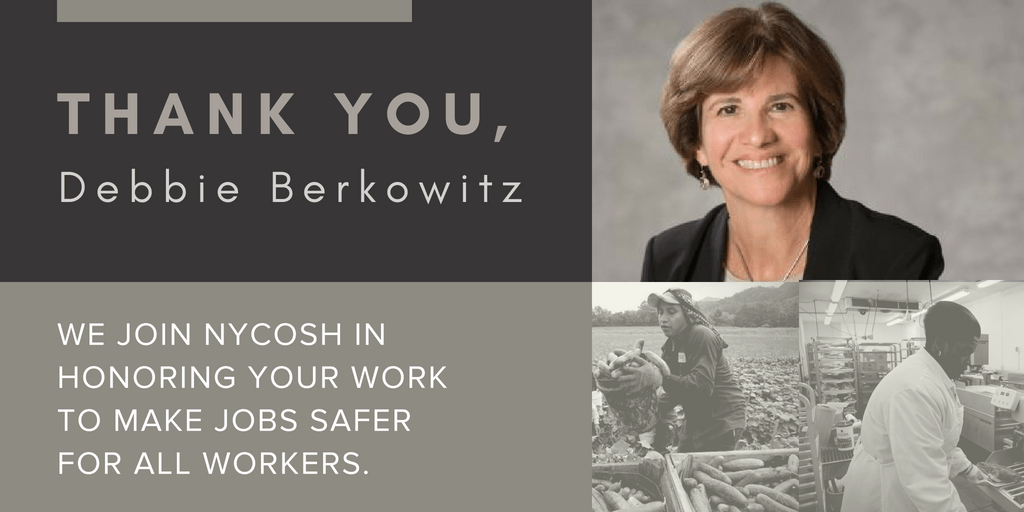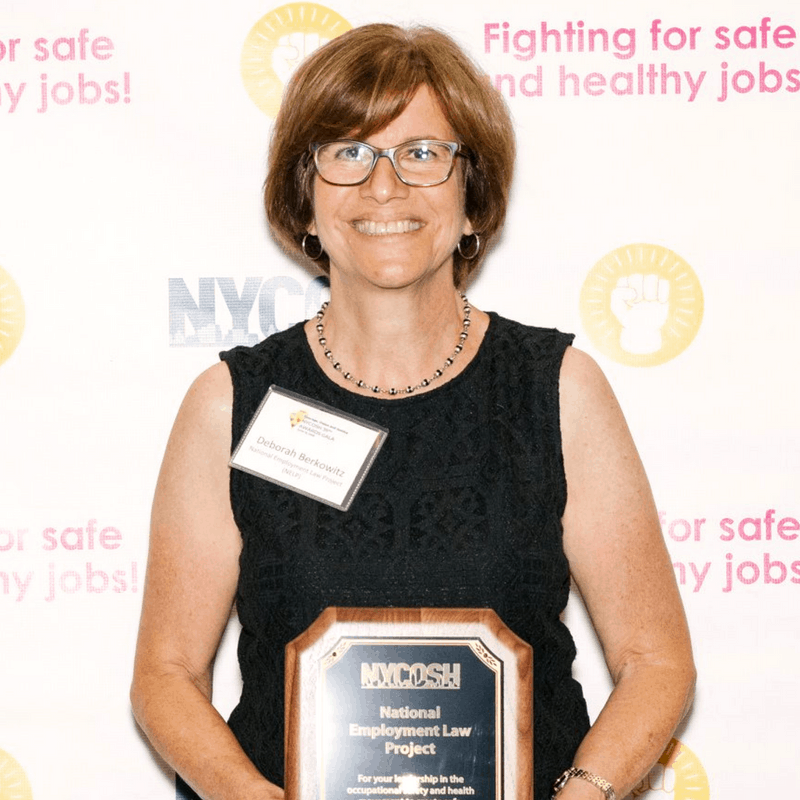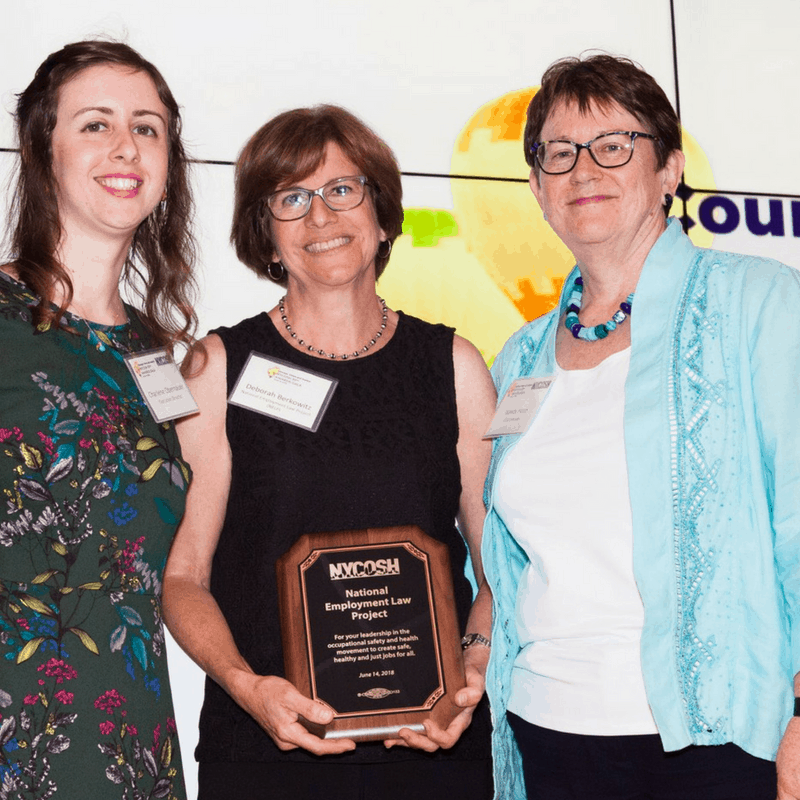
NYCOSH honored NELP at its 2018 Annual Awards Gala on June 14. Debbie Berkowitz leads NELP’s occupational safety and health advocacy and research.
Congratulations on this award. This is a big achievement. Looking back on your career, what are some of the key moments that shaped you as an advocate?
I started my career as a worker safety and health advocate at the AFL-CIO back in 1978. I was just one year out of college and was so fortunate to join a department of the AFL-CIO filled with young campaigners who were really smart about using research, data, and communications to help workers and local unions win better protections.
Just a few months after I started that job, I was thrown into my first real campaign on worker safety. A local TV station and environmental group had just broken the story that there was asbestos in hair dryers and that people who used them were exposed to the deadly fibers. I started working immediately with the Barbers and Beauticians Union (now part of the United Food and Commercial Workers Union) whose membership was truly scared about the health implications. We teamed up with a great environmental group and ran a campaign that resulted in most of the industry agreeing to voluntarily remove the asbestos.
Shortly after, I was part of a team that launched a campaign to win stronger protections for workers in grain elevators who were being killed in huge, deadly explosions. The danger was most noticeable in those big export elevators in major ports like New Orleans, Duluth, Minnesota, and Superior, Wisconsin—but even smaller facilities were blowing up. Grain dust was explosive and the industry needed to do much more than it was doing to prevent explosions and protect workers. But explosions were not the only risks—workers were suffocating in grain bins because of a lack of protection and they were also getting sick from very toxic pesticides used on the grain.
For eight years, I worked with local unions from the American Federation of Grain Millers and other international unions to fight for stronger protections from the Occupational Safety and Health Administration (OSHA) and the Environmental Protection Agency (EPA), which regulated these pesticides. I helped organize the campaign, but the activism and participation of the workers and the unions was really the reason we won a new OSHA standard in the grain industry. That same worker power and drive was also the reason that we succeeded in getting the EPA to ban the use of a very dangerous pesticide, FRP, in grain.
See the NYCOSH event facebook photo album
What does it take for public agencies and businesses to value worker safety and health?
The truth is that safety pays—companies save money when they do the right thing and prevent injuries and workplace fatalities. But all too often, safety falls to the back burner when there are other production issues. And unfortunately, the public agency charged with the responsibility to help protect worker safety has always been under attack by industry. The result is that OSHA is one of the smallest agencies—maybe one-seventh the size of the EPA—with the same national jurisdiction. The attacks on OSHA continue today. OSHA has fewer inspectors now than in 1980 for a workforce that is twice as large. Industry likes to claim that OSHA standards kill jobs. But the facts are clear: OSHA doesn’t kill jobs—the agency prevents jobs from killing workers.
Industry likes to claim that OSHA standards kill jobs. But the facts are clear: OSHA doesn’t kill jobs—the agency prevents jobs from killing workers.
We have to reinforce to the public and business that safety pays—providing training and safety protections save lives and is also good for the bottom line. It’s the right thing to do in every way. Dangerous jobs hurt workers, families and communities. The impact is huge: enormous pain and suffering for the injured worker and their family, and billions a year in direct and indirect costs to businesses and the economy. Companies must be held accountable when they cut corners and expect workers to pay the price.
The impact is huge: enormous pain and suffering for the injured worker and their family, and billions a year in direct and indirect costs to businesses and the economy. Companies must be held accountable when they cut corners and expect workers to pay the price.
How can workers advocate for themselves and their co-workers for safer jobs?
If workers in dangerous industries don’t advocate, the odds are, they won’t have safe conditions. If they are lucky, they might work for a company that does this right—that takes their well-being and safety seriously. But many companies don’t. That’s why there are more than 2.8 million serious injuries every year reported by industry and more than 5,000 workers killed on the job each year. If workers face job hazards, they need to speak up. That can be scary—but they can band together and work with their union or find assistance from community groups to help them raise their voices and demand safer conditions. There is no private right of action with OSHA—where workers can sue for safer conditions. But they can and should file a complaint with OSHA and ask for an investigation. They can also enlist their community and the public in their struggles.
What are you working on this summer?
I am going to keep the Trump administration’s feet to the fire as they continue to roll back worker protections. The public needs to know that this administration is not putting the interests of workers first. We just wrote a paper explaining how, despite rising work-related fatalities, OSHA is cutting back on its enforcement activity. We are working with a coalition to prevent rollbacks of other OSHA protections and also EPA farmworker pesticide protections. The EPA wants to allow children to apply the most dangerous pesticides. That is very scary.
We will also be working hard to oppose an effort by the Trump administration’s USDA as it tries to increase line speeds in poultry and meat plants. This will really drive injury rates up among a population of workers that already faces some of the highest injury rates.
We will also be working with wonderful allies in a few states to actually increase worker safety protections. And I am hoping to finish a toolkit for allies on how to improve workers’ compensation systems—especially in states that have some of the weakest laws with rock bottom benefits.
How do you maintain the intensity needed to speak up for working people?
I fall back on remembering my first decade as a workplace safety and health advocate—though we had an unfriendly administration, we really achieved so much. When I first started in this field, workers didn’t even have the right to know the names of the chemicals they worked with or get copies of their company-maintained medical records that showed how these chemicals were impacting their health. The truth is, we have come a long way. I have met with so many workers over the years who fought so hard and believed in what they were fighting for. Thinking of them, I have become completely passionate about this work.
The truth is, we have come a long way. I have met with so many workers over the years who fought so hard and believed in what they were fighting for. Thinking of them, I have become completely passionate about this work.
I also needed to build a good support system. You often lose in these struggles for better protections—and that is really hard, especially when the facts are often on your side. I am totally lucky to have always had colleagues at work and in the worker health and safety field who I can completely rely on for mutual support.
This November, I will have been doing this work for 40 years. I have learned how important it is to take time to have a life—to build a world outside of these struggles that you love to be in. I am passionate about my work, but my family has truly been my greatest joy. Remember, take time for yourself—the work will always be there.
Related to
The Latest News
All newsNew Report Details Employers’ Harmful Use of Digital Surveillance and Automated Decision Systems, Highlights Urgent Need for Policy Action

News Release
D.C. Council Rejects Rollback of Minimum Wage for Tipped Workers

News Release
Mayor Bowser & D.C. Council Must Respect the Will of D.C. Voters by Rejecting Repeal of Initiative 82

Blog



